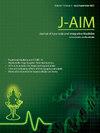综合方案在运动损伤踝关节扭伤治疗中的疗效——一项随机对照临床试验
IF 1.9
Q3 INTEGRATIVE & COMPLEMENTARY MEDICINE
引用次数: 0
摘要
在运动员中,踝关节扭伤是最常见的损伤,发生率为12.62%。当使用补充和替代药物时,可以更有效地预防和治疗运动损伤。在阿育吠陀中,踝关节损伤与Gulpha(踝关节)marmabhighata(对健康的重要关注点的损伤)相关,并相应地进行管理。使用阿育吠陀和物理治疗方案的综合方法需要一个小时才能产生基于证据的结果。目的评价运动损伤踝关节扭伤综合治疗方案的疗效。材料与方法入选符合纳入标准和排除标准的踝关节扭伤患者30例。在获得知情同意后进行综合和标准程序,并将参与者分为两组,即治疗组(综合方法)和对照组(标准方法)。在整个研究过程中,疼痛、肿胀、温度、压痛、活动范围和手动肌肉测试等参数均在基线和不同时间点(第6、11和18天)进行测量。统计分析采用Mann-Whitney U检验、Wilcoxon配对检验、独立t检验和依赖t检验对数据进行分析。结果治疗组(组内和组间)在疼痛、压痛、体温、肿胀、活动度、手肌测试等指标上均明显优于对照组。结论采用阿育吠陀与物理治疗相结合的方法治疗踝关节扭伤比常规方法更有效。本文章由计算机程序翻译,如有差异,请以英文原文为准。
Efficacy of integrated protocol in the management of ankle sprain in sports injuries - A randomized controlled clinical trial
Background
Among athletes, ankle sprains are the most frequent injury, with an prevalence of 12.62% of all injuries. Sports injuries can be prevented and treated more effectively when complementary and alternative medicine is used. In Ayurveda ankle joint injuries are correlated with Gulpha (ankle) marmabhighata (injury to important point of concern for health) and management is done accordingly. Integrated approach using Ayurveda and Physiotherapy protocol is the need of hour to produce evidence-based results.
Objectives
To evaluate the efficacy of the integrated management protocol of ankle sprain in sports injuries.
Materials and methods
A total of 30 patients with ankle sprains were recruited after satisfying the inclusion and exclusion criteria. The procedures (Integrated and Standard) were performed after obtaining informed consent, and the participants were divided into two groups, i.e., the treatment group (integrated approach) and the control group (standard approach). Parameters like pain, swelling, temperature, tenderness, range of motion and manual muscle testing were all measured at baseline and at various time points (6th, 11th, and 18th day) throughout the study.
Statistical analysis
The data was analysed with the Mann-Whitney U test, Wilcoxon matched pairs test, independent 't’ test, and dependent ‘t'test.
Results
The treatment group has shown significantly better results (within and between groups) than the control group in relation to all the parameters like pain, tenderness, temperature, swelling, range of motion, and manual muscle testing.
Conclusion
An integrated approach using Ayurveda and physiotherapy was found to be more effective than the standard approach in the management of ankle sprains.
求助全文
通过发布文献求助,成功后即可免费获取论文全文。
去求助
来源期刊

Journal of Ayurveda and Integrative Medicine
INTEGRATIVE & COMPLEMENTARY MEDICINE-
CiteScore
4.70
自引率
12.50%
发文量
136
审稿时长
30 weeks
 求助内容:
求助内容: 应助结果提醒方式:
应助结果提醒方式:


